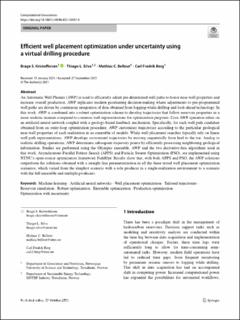| dc.contributor.author | Kristoffersen, Brage Strand | |
| dc.contributor.author | Silva, Thiago Lima | |
| dc.contributor.author | Bellout, Mathias | |
| dc.contributor.author | Berg, Carl Fredrik | |
| dc.date.accessioned | 2022-05-03T07:57:11Z | |
| dc.date.available | 2022-05-03T07:57:11Z | |
| dc.date.created | 2021-11-05T12:56:47Z | |
| dc.date.issued | 2021 | |
| dc.identifier.citation | Computational Geosciences. 2021, . | en_US |
| dc.identifier.issn | 1420-0597 | |
| dc.identifier.uri | https://hdl.handle.net/11250/2993763 | |
| dc.description.abstract | An Automatic Well Planner (AWP) is used to efficiently adjust pre-determined well paths to honor near-well properties and increase overall production. AWP replicates modern geosteering decision-making where adjustments to pre-programmed well paths are driven by continuous integration of data obtained from logging-while-drilling and look-ahead technology. In this work, AWP is combined into a robust optimization scheme to develop trajectories that follow reservoir properties in a more realistic manner compared to common well representations for optimization purposes. Core AWP operation relies on an artificial neural network coupled with a geology-based feedback mechanism. Specifically, for each well path candidate obtained from an outer-loop optimization procedure, AWP customizes trajectories according to the particular geological near-well properties of each realization in an ensemble of models. While well placement searches typically rely on linear well path representations, AWP develops customized trajectories by moving sequentially from heel to the toe. Analog to realistic drilling operations, AWP determines subsequent trajectory points by efficiently processing neighboring geological information. Studies are performed using the Olympus ensemble. AWP and the two derivative-free algorithms used in this work, Asynchronous Parallel Pattern Search (APPS) and Particle Swarm Optimization (PSO), are implemented using NTNU’s open-source optimization framework FieldOpt. Results show that, with both APPS and PSO, the AWP solutions outperform the solutions obtained with a straight-line parameterization in all the three tested well placement optimization scenarios, which varied from the simplest scenario with a sole producer in a single-realization environment to a scenario with the full ensemble and multiple producers | en_US |
| dc.language.iso | eng | en_US |
| dc.publisher | Springer | en_US |
| dc.rights | Navngivelse 4.0 Internasjonal | * |
| dc.rights.uri | http://creativecommons.org/licenses/by/4.0/deed.no | * |
| dc.title | Efficient well placement optimization under uncertainty using a virtual drilling procedure | en_US |
| dc.type | Peer reviewed | en_US |
| dc.type | Journal article | en_US |
| dc.description.version | publishedVersion | en_US |
| dc.rights.holder | © The Author(s) 2021 | en_US |
| dc.source.pagenumber | 18 | en_US |
| dc.source.journal | Computational Geosciences | en_US |
| dc.identifier.doi | 10.1007/s10596-021-10097-4 | |
| dc.identifier.cristin | 1951781 | |
| dc.relation.project | Norges forskningsråd: 262644 | en_US |
| cristin.ispublished | true | |
| cristin.fulltext | original | |
| cristin.qualitycode | 1 | |

